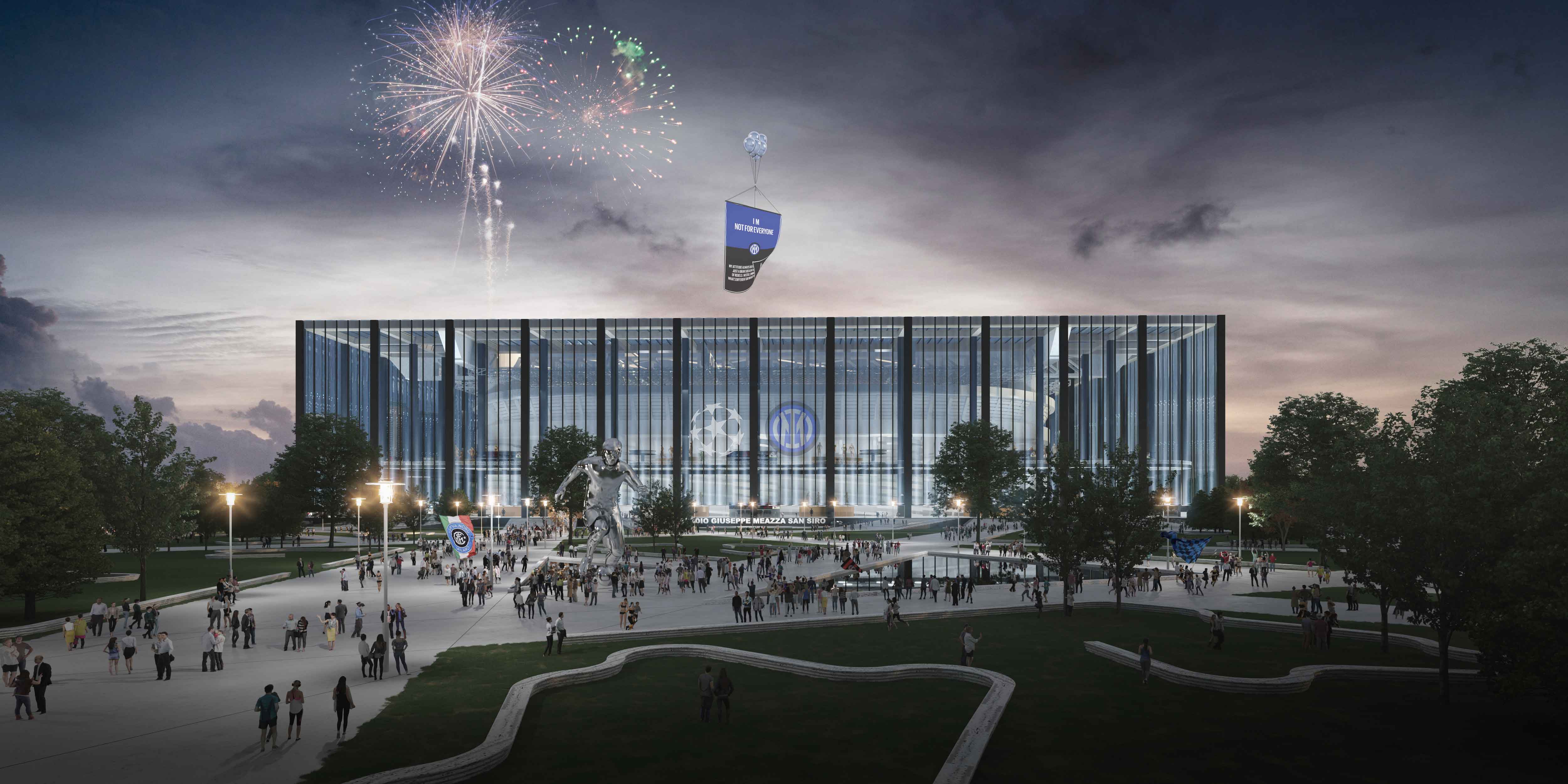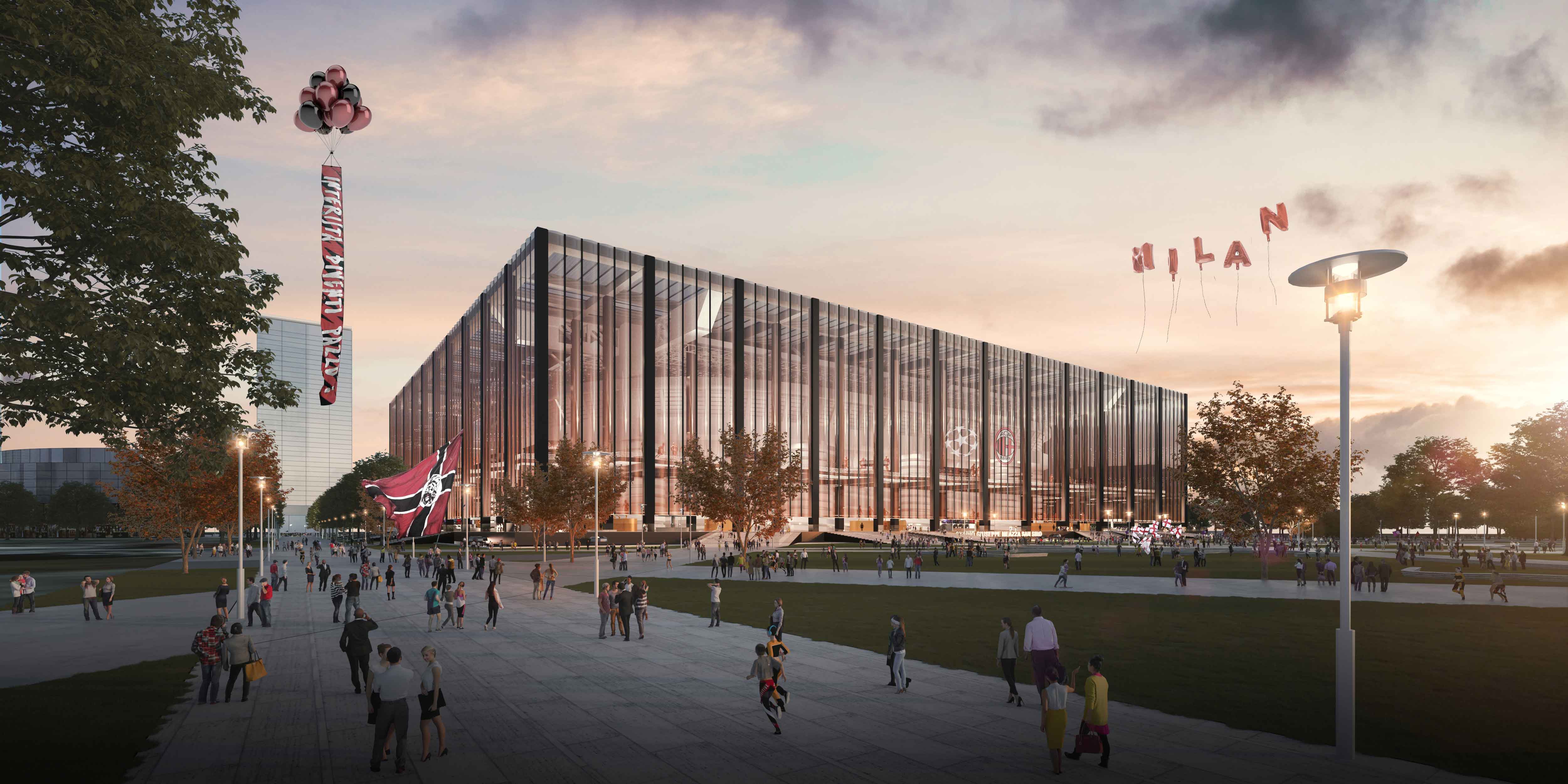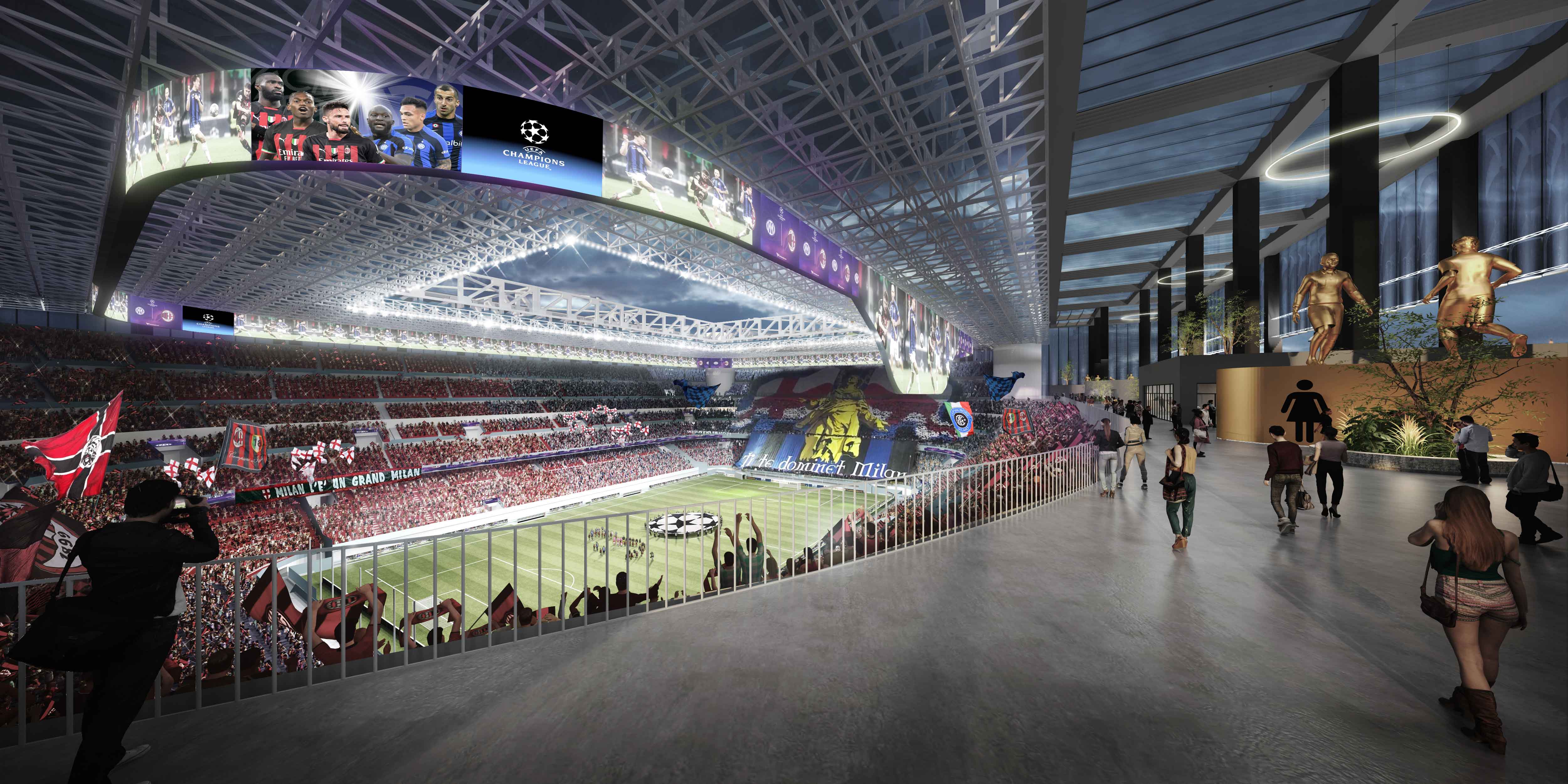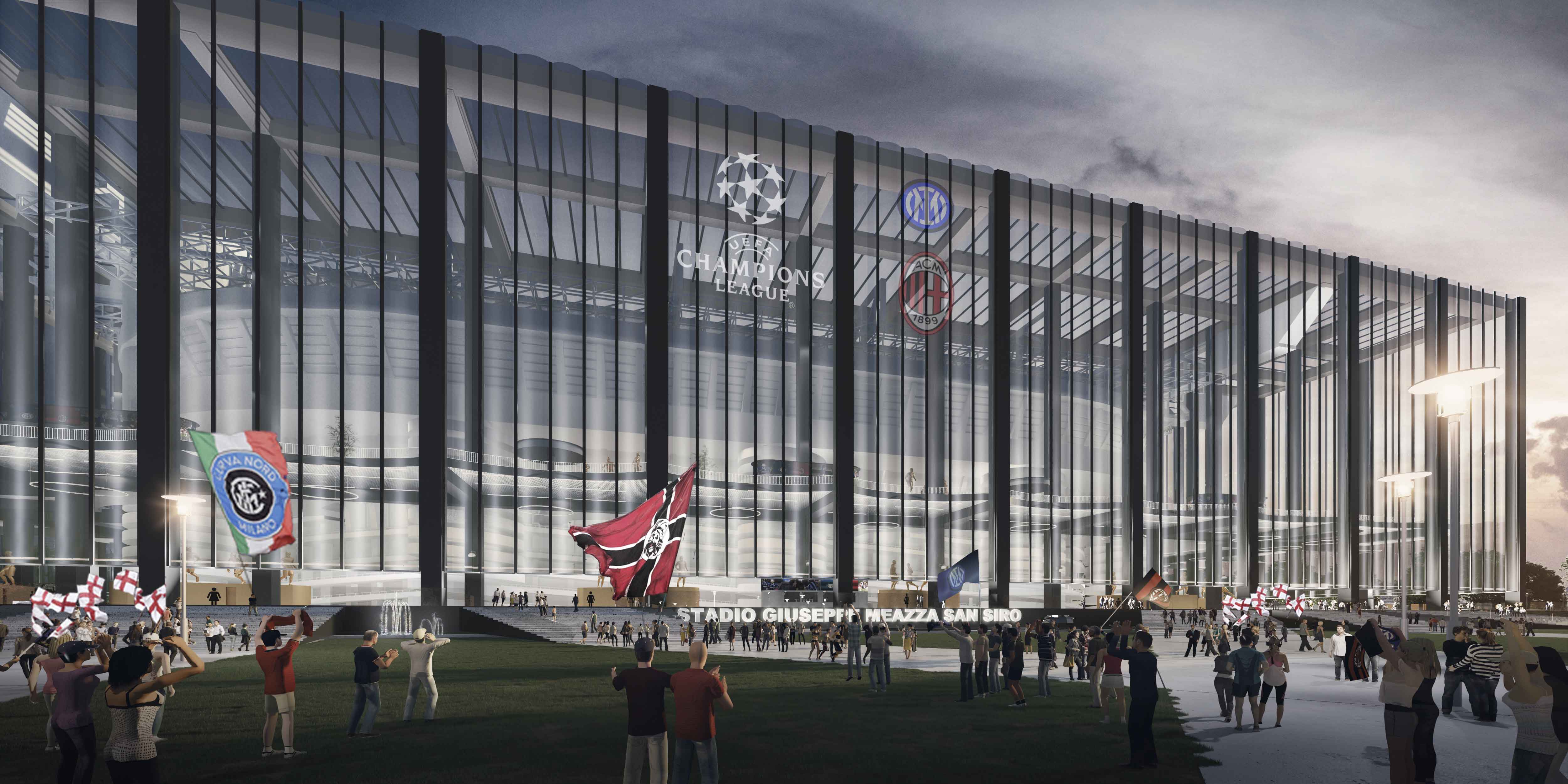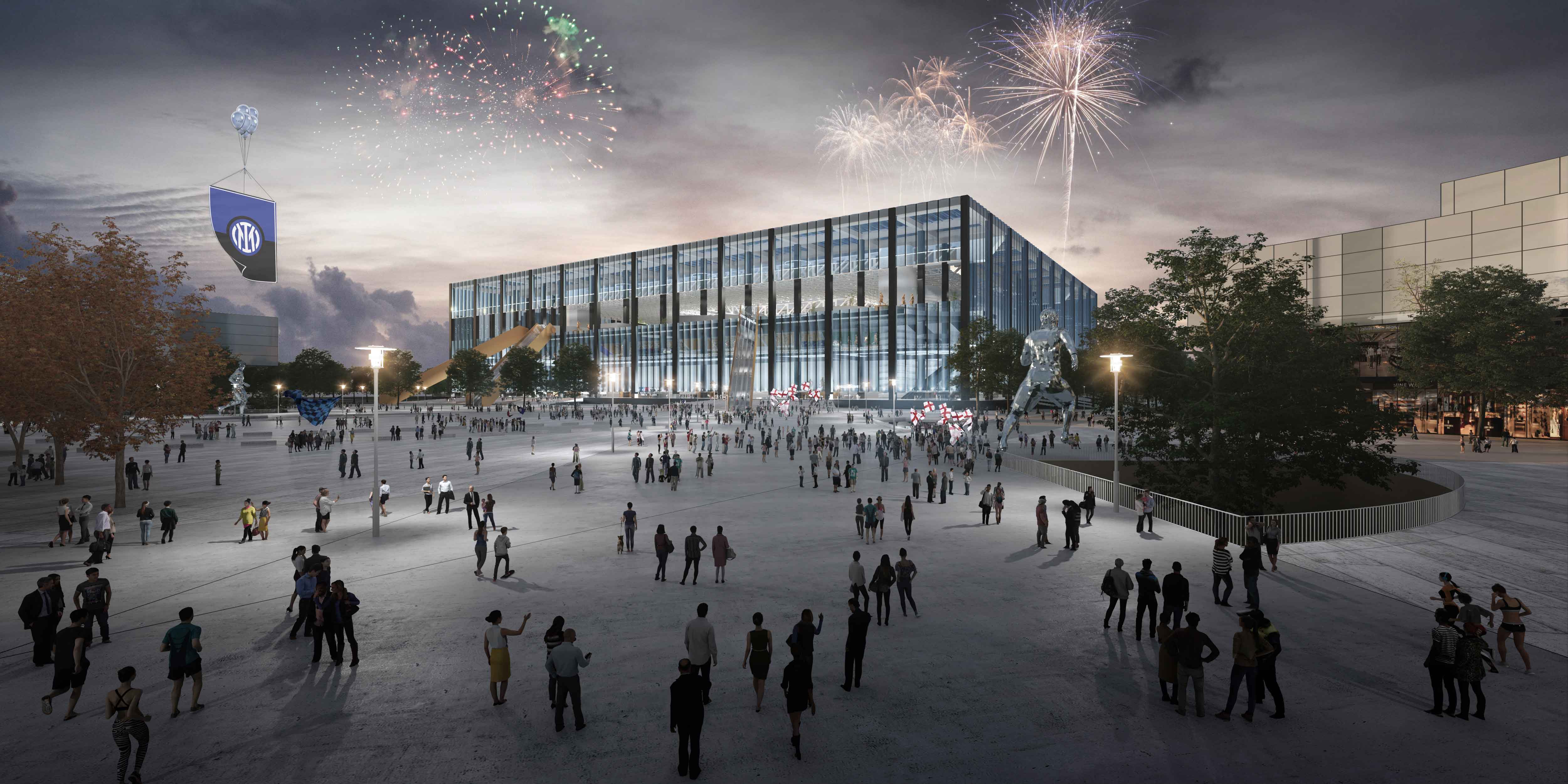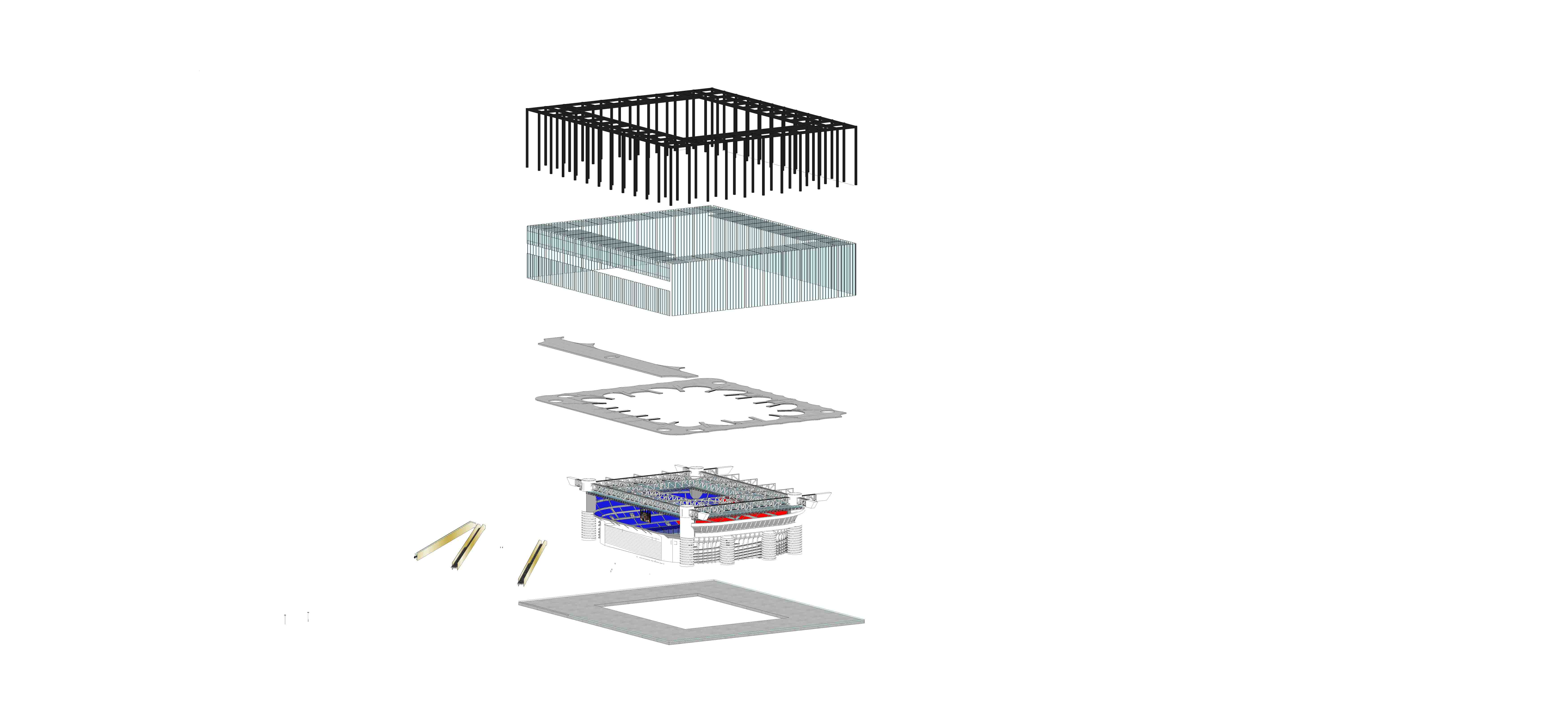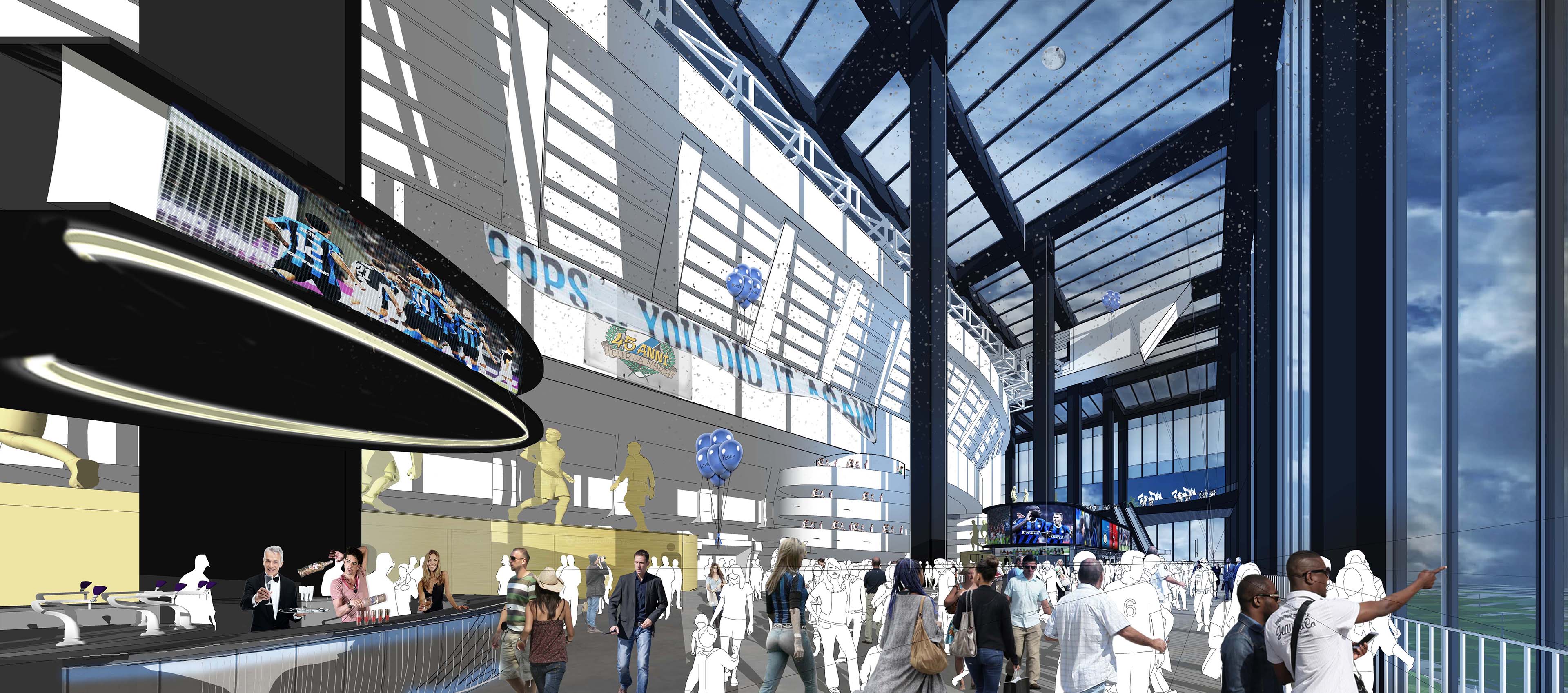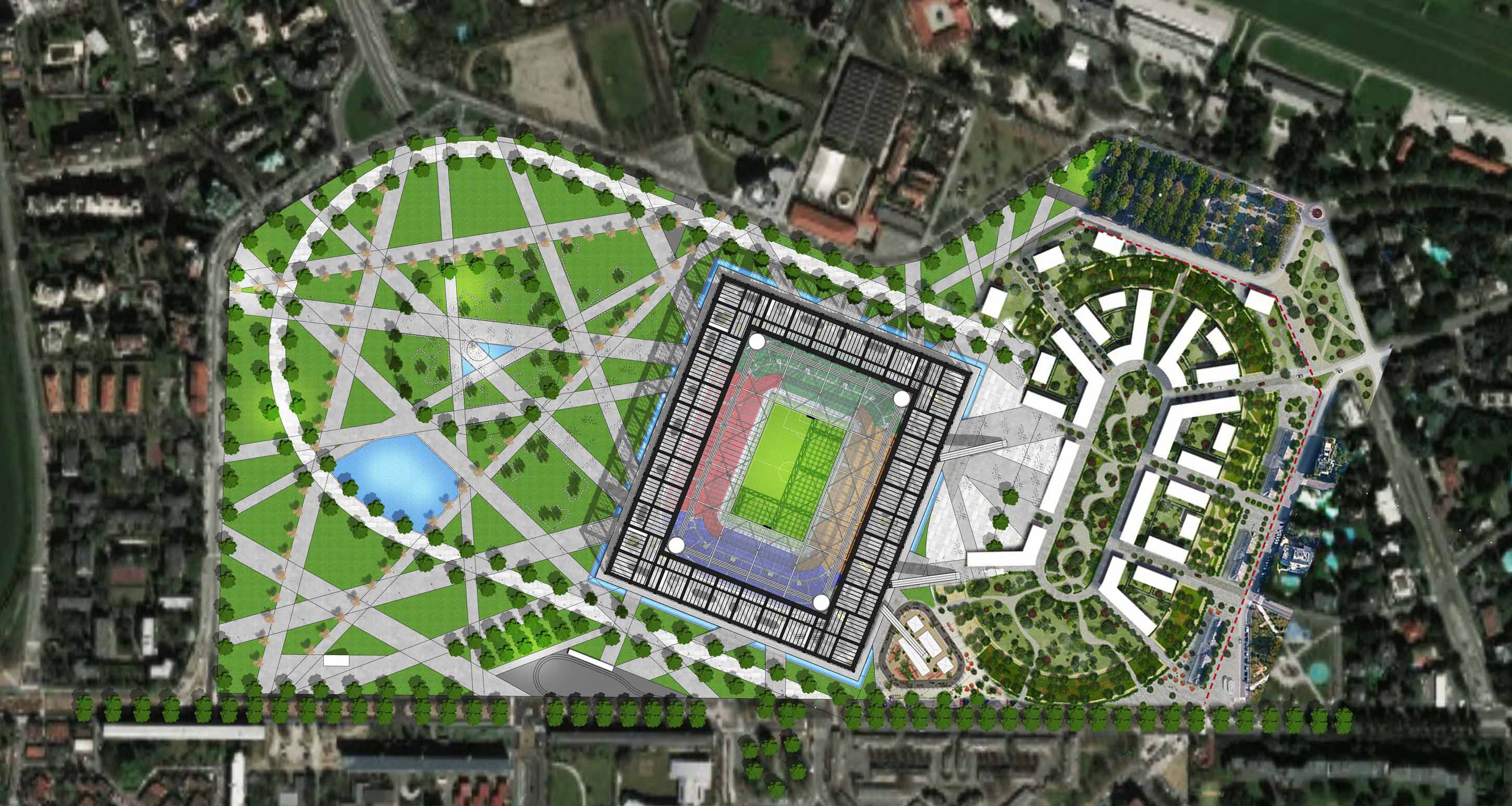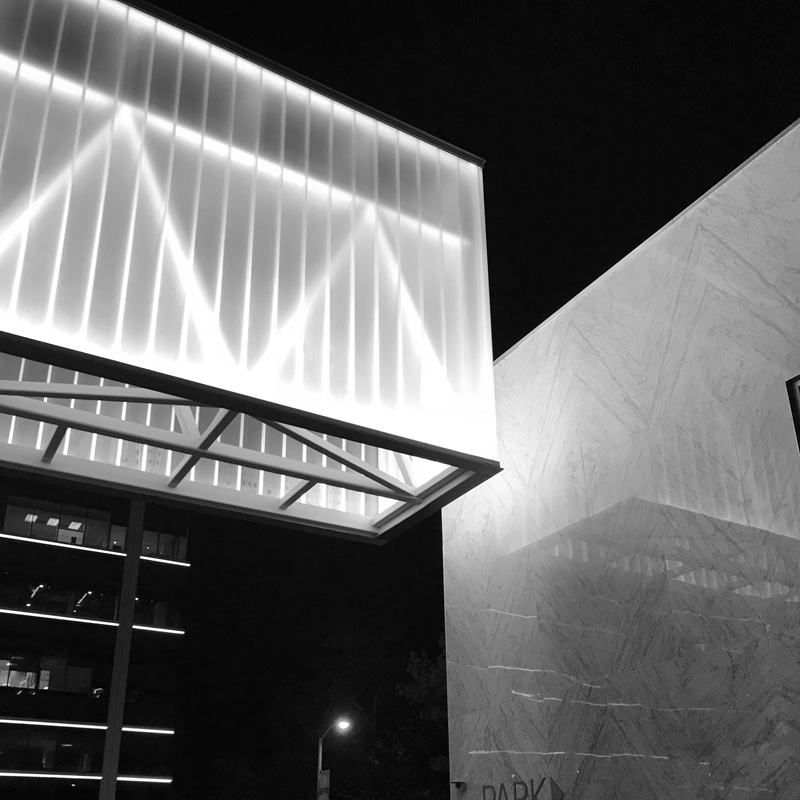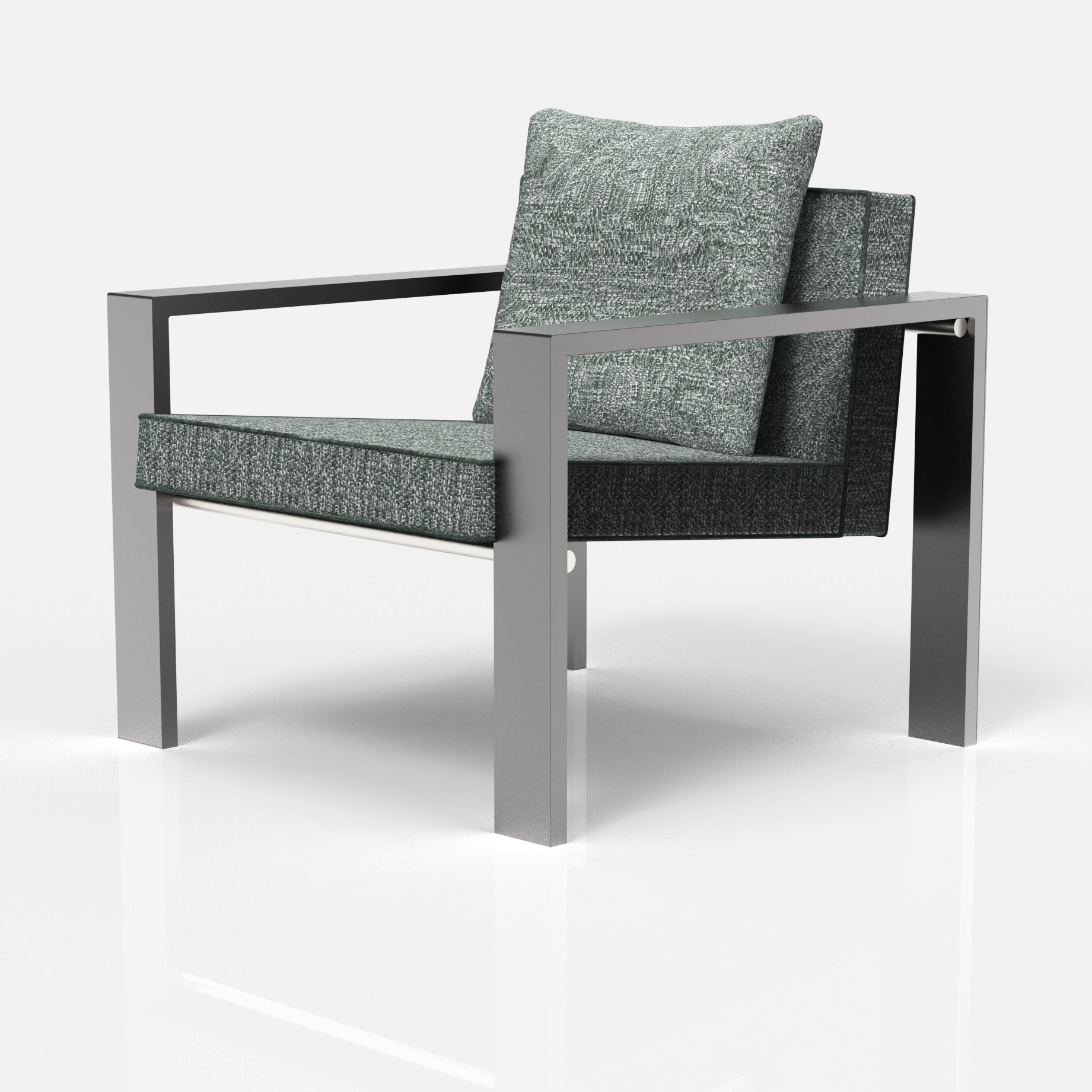
STADIUM G. MEAZZA, SAN SIRO
PROPOSAL San Siro Nuovo Stadio Meazza – Project summary.
San Siro Nuovo Stadio Meazza – Descrizione sommaria di progetto
Il progetto consiste in una “creative enhanced conservation” o “conservazione creativa accentuata” --- un concetto che supera la mera conservazione o ristrutturazione. Si vuole valorizzare l’ architettura esistente migliorandola con aggiunte importanti e inserimenti opportuni che la trasformano radicalmente, mantenendone intatta l’identita’,
e addirittura rafforzandola in una nuova composizione.
Il progetto e’ caratterizzato da un colonnato ad “ordine gigante” tutto intorno allo stadio esistente. Colonne e travi nere chiuse da una pelle di ETFE o vetro che si puo’ illuminare di azzurro o rosso creando con l’architettura stessa gli iconici colori dell’ Inter e Milan. Dentro il nuovo involucro trasparente, la magnifica struttura del Meazza, interamente pitturata di bianco, risalta in contrasto, come un’ architettura nell’ architettura creando una nuova costruzione contemporanea e unica.
Per la terza volta una nuova struttura si aggiunge ad avvolgere l’edificio dello Stacchini del 1925, l’ ampliamento
Calzolari-Ronca del 1953 e l’incredibile bellissima costruzione del Ragazzi del 1989.
Lo stadio resta il fantastico “fuori-scala” immerso nel verde del nuovo parco che mitiga la relazione con gli edifici del quartiere. E’ importante che il parco mantenga il livello del tessuto urbano circostante per avere la corretta relazione urbanistica con tutto il quartiere San Siro.
Nell’ area del trotter e’ prevista la grande nuova “Piazza dei Campioni” con il disegno in pianta che mantiene la memoria dell’ impronta dello storico impianto del trotto. Il nuovo stadio diventa parte dell’ architettura che forma la piazza insieme agli edifici curvi aggettanti e alla alta torre residenziale (circa 27,000mq di retail e 245,000mq di residenze e/o uffici se necessari). Le scale mobili esterne danno accesso diretto al “piano belvedere commerciale” al livello del terzo anello. Le Scuderie Vietti sono mantenute e ristrutturate con le nuove scale mobili che si inseriscono per contrasto tra vecchio e nuovo. Sotto alla piazza si prevedono parcheggi multilivello sotterranei. Anche sotto al Parco dei capitani si possono prevedere parcheggi sotterranei accessibili dal sottopassaggio Patroclo.
Un’ opzione alternativa integra il nuovo stadio con il piano attuativo a residenze nel verde creando una ridotta “Piazzetta dei Campioni”.
Il progetto si sviluppa considerando e sfruttando le rampe esistenti e il sitema di circolazione/ uscite esistente, connettendo strategicamente la soletta della concourse del secondo anello all’entrata alle gradinate delle rampe che avvolgono lo stadio.
I vuoti a doppia altezza sono “ricamati” intorno alle rampe elicoidali, tra le diverse entrate e tra le colonne perimetrali.
Sulla nuova concourse di circa 25,000mq si collocano i volumi dei nuovi bagni (immaginati in finitura oro come piedistalli di statue dei campioni piu’ rappresentativi della storia di Milano) e le concessioni commerciali di ristoro e retail con coperture avvolte da digital displays. Tutto per il comfort prima e durante la partita come nei contemporanei stadi attuali.
Sul lato est, dove il terzo anello e’ correntemente lasciato aperto, c’e’ il nuovo “piano belvedere sulla citta’”.
Circa 11,000 mq di possibile centro commerciale, ristoranti,museo etc..(da definire con il programma piu’ idoneo) anche accessibile direttamente dalla nuova “Piazza dei Campioni” con scale mobili esterne e che funzionerebbe sempre, anche quando lo stadio non ospita partite.
Si prevede la possibilita’ di poter aprire tutta la facciata est verso la citta’.
Il piano di ingresso allo stadio viene rialzato al livello della esistente entrata dei distinti (vedi sezioni) cosi’ che resta al di sopra dei ground boxes. Si stabilisce una entrata monumentale con scalinate dal parco. Qui la councourse di servizio al primo anello e’ di circa 30,000 mq con i volumi dei nuovi bagni (immaginati in finitura oro come piedistalli di statue dei campioni piu’ rappresentativi della storia di Milano) e le concessioni commerciali di ristoro e retail con coperture avvolte da digital displays. Uno specchio d’acqua stacca la “piattaforma” dal parco e fa’ “galleggiare” l’architettura (oltre a creare una separazione per questioni di sicurezza e gestione delle entrate). Entrate VIP si possono prevedere scendendo dal parco al piano interrato (vedi sezioni).
Gli spazi attualmente usati per i bagni esistenti al primo e secondo anello possono essere riprogrammati per spazi di supporto alle operazioni di servizio o essere usati per migliorare sky boxes e sky lounges.
Gli sky boxes e sky lounges possono essere estesi anche nel settore arancio, blue e verde al top del primo anello.
Le gradinate del terzo anello potrebbero essere ri-prefabbricate a gradoni piu’ larghi riducendone la capacita’ del 20% circa e costruendole circa 10 metri piu’ indentro, piu’ vicine al campo, di poco sovrapposte al secondo anello.
Strutturalmente il nuovo involucro e’ indipendente dalla costruzione esistente.
Siccome il progetto mantiene le rampe esistenti come base di circolazione, il cantiere puo’ organizzarsi in fasi concentrate nel periodo off season per l’inizio dei lavori e mantenendo aperto l’impianto durante la costruzione come si e’ verificato nel 1988/89 (vedi disegno con schema per fasi di cantiere). Solo il terzo anello si puo’ mantenere chiuso per tutta la durata della costruzione con la possibilita’ di lavorare “dall’alto” con le gru montate sulla struttura del terzo anello (sulle 4 torri agli angoli e o sulla trave a cassone che sorregge le gradinate).

